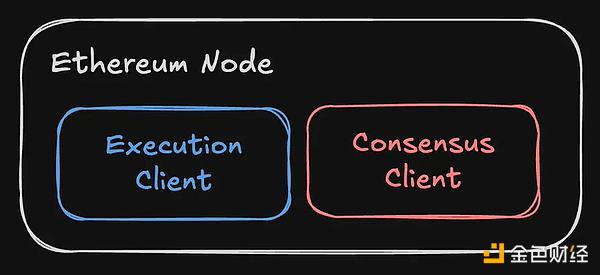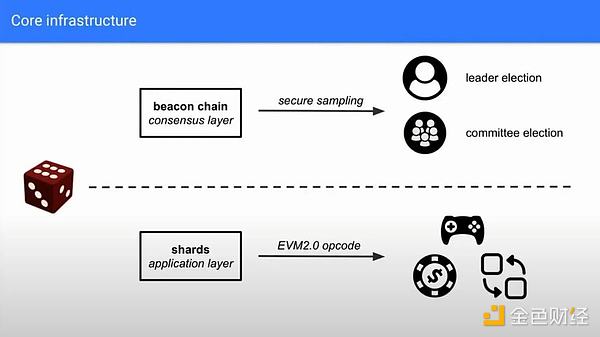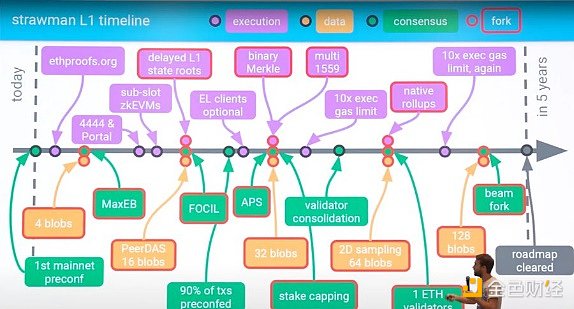Author: Jarrod Watts, Developer Relations Engineer at Abstract; Author: Jinse Finance xiaozou
Beam Chain was the biggest announcement at the Devcon Summit, introducing 9 major upgrades to Ethereum. But most people don't quite understand these upgrades, and this article will help you better understand these 9 upgrades.
Beam Chain is Justin Drake's proposal to redesign the Ethereum Consensus Layer (CL). Before we delve into the specific upgrades, let's take a quick look at what the Ethereum consensus layer actually is.
Each Ethereum node runs two components: the execution client and the consensus client.

The consensus client is used by nodes to "agree" on what the next block in the blockchain is. You can stake 32 ETH to add a third component - a validator, who gets rewarded for proposing new blocks through the proof-of-stake algorithm.

So why does the Ethereum consensus layer need a redesign?
There are several problems with CL at the moment:
These 9 upgrades can be divided into 3 categories:
1/Block Production
2/Staking
3/Encryption
Next, I will summarize each upgrade separately.
Upgrade 1: Censorship Resistance
Current block production is very centralized. Two major block builders - Beaver Build and Titan Build - almost monopolize all Ethereum blocks:

These builders create blocks in such a way as to maximize their profits in the form of MEV; arbitrarily include, exclude, or reorder transactions in the blocks they produce.
Today, if your transaction is not favorable to one of the two block builders, they may choose to exclude your transaction from the block and censor your transaction.
This upgrade, proposed in EIP-7805, increases Ethereum's censorship resistance by allowing validators to select transactions from the memory pool and force their inclusion through inclusion lists (ILs), which builders must follow in order to have their blocks included by the network.
In the Beam Chain upgrade, 16 validators per slot will build a list of transactions that must be included by block builders, which means that block builders no longer have the ability to censor transactions.
Upgrade 2: Segregated Validation
Attester Proposer Separation (APS) separates witnesses and proposals, such as executing auctions.
While validators can build transaction blocks themselves, most use so-called "MEV boost" to hand off block building to someone else (usually Beaver Builder or Titan build), who pays the validator a fee.
The two parties are called:
- Witnesses (validators)
- Proposers (block builders)
Today there is a separation between the two - i.e. validators accept blocks from proposers, however, it is centralized through trusted intermediate relayers.
Relayers like Flashbots act as "middlemen" to facilitate transactions between validators who want to sell blocks and block builders who want to create profitable blocks.
APS is an upgrade that adds or "embeds" this separation between validators and proposers into Ethereum in a decentralized way; reducing the centralization risk of relayers like Flashbots.
One way to achieve this separation is to implement auctions; a system where anyone can buy a ticket, giving them a chance to win the right to create a future block.
Upgrade 3: Faster slots
On Beam Chain, slots will go from 12 seconds to 4 seconds.
Slots are the period of time that a validator can propose a new block and get the consent of other validators.
Faster slots means faster transaction finality and higher transaction throughput.
Upgrade 4: Smarter issuance (such as staking cap)
The issuance curve refers to how new ETH is created and distributed over time.
Currently:
-ETH is issued to validators as a reward every epoch (about 6 minutes).
-ETH is burned as part of each transaction.
Depending on network activity, ETH fluctuates between inflation and deflation. For example, in one hour, you can see that ETH is inflationary, as more ETH rewards are issued than burned in transactions:

There is a lot of debate in the community about whether and how issuance should change, but Justin Drake mentioned the staking cap in his Beam Chain presentation. The staking cap sets the maximum amount of ETH that can be staked in order to provide more predictable rewards to validators, and may have the goal of making ETH deflationary.
Upgrade 5: Smaller Validators
Currently, you need to buy 32 ETH to become a single validator on Ethereum. At today's prices, that's about $100,000.
Beam Chain proposes to reduce it to 1 ETH, which will help solve some centralization issues of liquidity staking providers such as LIDO or Coinbase, which currently control nearly 40% of the staked ETH:

Users who want to run validators for rewards but do not have 32 ETH will benefit from this upgrade, they will be able to run a validation node with only 1 ETH.
The next upgrade (Pectra) will allow stakers to stake more than 32 ETH as well, up to 2048. This means that on Beam Chain, users will be able to stake 1-2048 ETH.
Justin mentioned the Orbit staking method, which depicts a system in which larger validators are elected more frequently and receive small rewards frequently, while smaller validators are elected less frequently but receive larger rewards.
Upgrade 6: Faster Finality (like 3 Slot FFG)
Currently, it takes about 15 minutes (64 slots) for Ethereum to finalize a transaction.
Single-Slot-Finality has been proposed as a way to reduce this time to 1 slot, but a newer proposal - 3-Slot-Finality - may actually be faster because it runs in parallel with voting rounds.
This means that a transaction will be finalized in 36 seconds instead of 15 minutes. This is especially important for services that rely on L1 finality, such as DeFi applications or cross-chain/interoperability protocols.
Upgrade 7: Chain Snarkification
Beam Chain hopes to “snarkify” the consensus layer (using ZK-SNARKs, a secure ZK proof). Justin Drake calls it the “ZK Era”.

Specifically, Beam chain proposes to use ZK-SNARKs to:
- Compile beam chain deployments in different languages into zkVM bytecode.
- Aggregate signatures generated by witnesses into ZK proofs.
ELI5 here refers to the fact that ZK technology has made great progress in the past 5 years, and Ethereum hopes to deploy it natively at both the consensus layer and the execution layer.
Upgrade 8: Quantum Security
Today, quantum computers can crack parts of Ethereum, such as cracking your private key or forging signatures in transactions using methods such as Shor's algorithm.
Quantum computers are likely to be available to people in the next decade; therefore, the Beam Chain proposal hopes to provide Ethereum security for the future post-quantum world by using methods such as hash signatures with post-quantum security.
Upgrade 9: Strong Randomness
Finally, the Beam Chain upgrade proposes a method for building a randomness source using a new primitive called VDF (Verifiable Delay Function).
Justin Drake talked about this in 2018, saying that this can be used for:
Consensus layer - for example, randomly selecting validators.
Application layer - for example, exposing an opcode that can provide verifiable randomness.
This is not possible today without third-party services such as Chainlink or Pyth VRF.

In addition to these 9 upgrades, the Beam Chain upgrade will also clean up most of its existing technical debt and unnecessary components, which will become redundant after the upgrade.
For example, faster slot finality may mean that epochs are not needed.

But some people think that the time span of Beam Chain is too long. However, Justin later clarified that Ethereum will continue to receive updates during these 5 years.
The Beam chain fork will take 5 years, including continuous upgrades to Ethereum.

 JinseFinance
JinseFinance
 JinseFinance
JinseFinance JinseFinance
JinseFinance Anais
Anais Edmund
Edmund JinseFinance
JinseFinance JinseFinance
JinseFinance JinseFinance
JinseFinance JinseFinance
JinseFinance JinseFinance
JinseFinance Cointelegraph
Cointelegraph